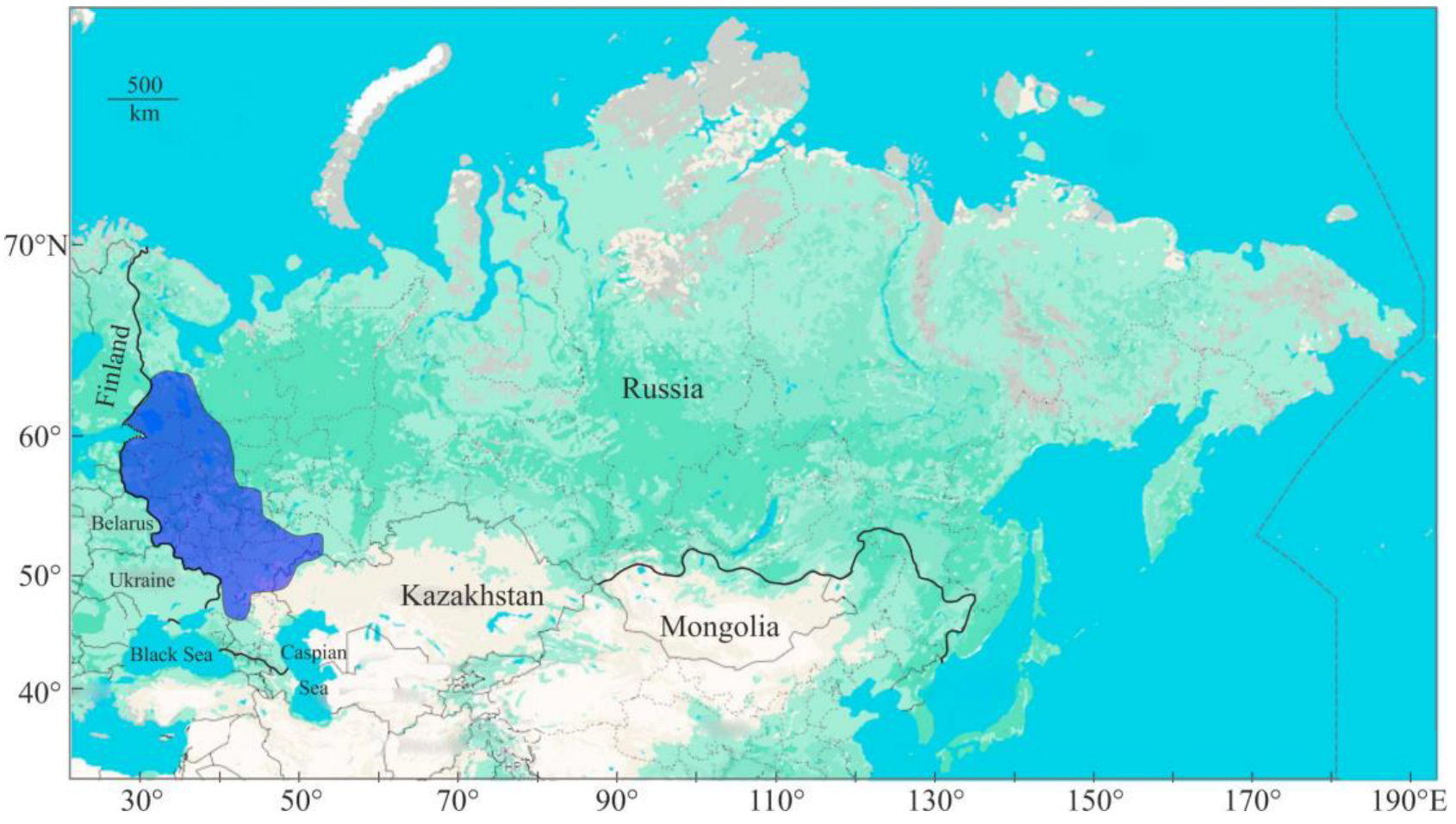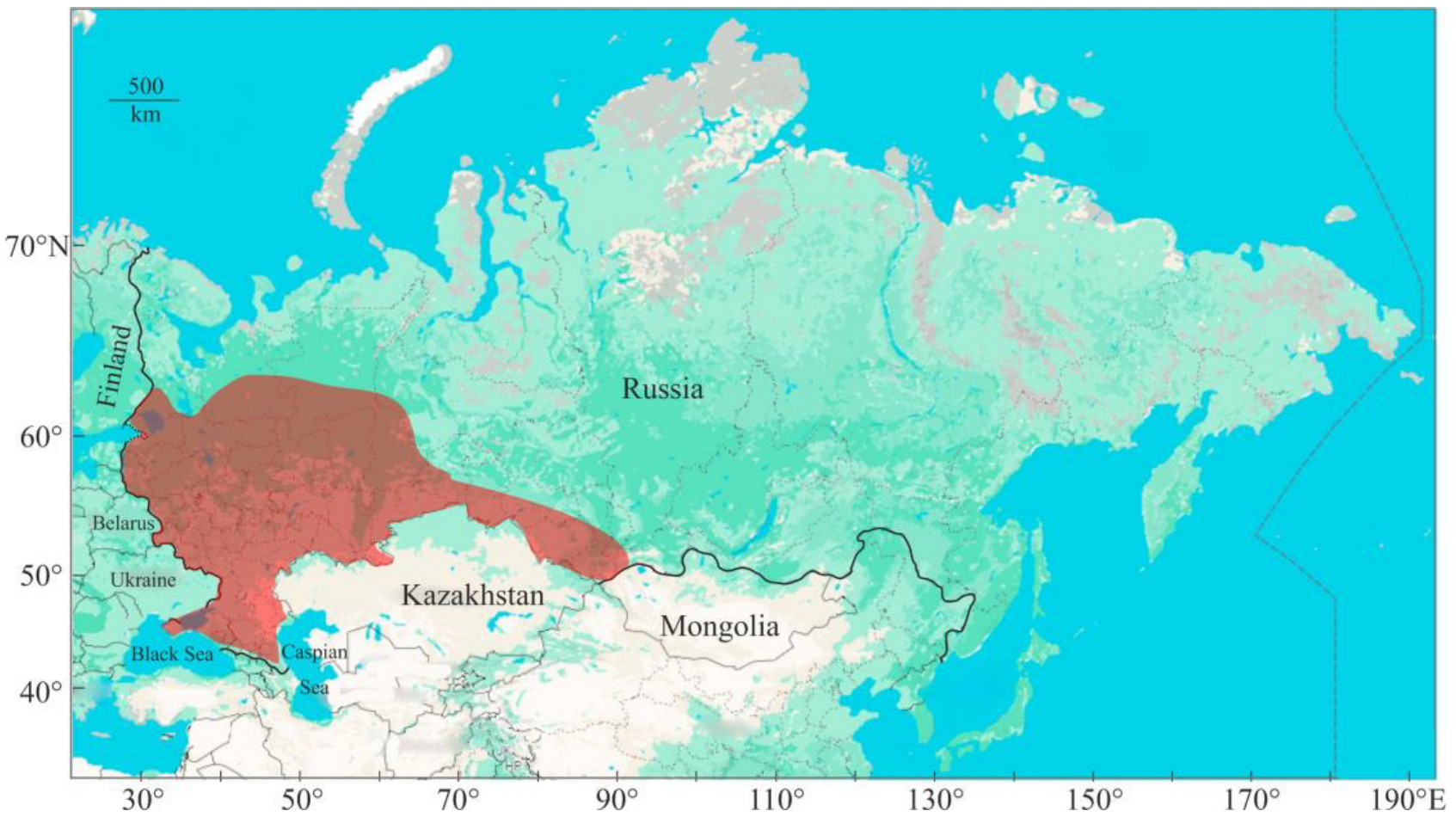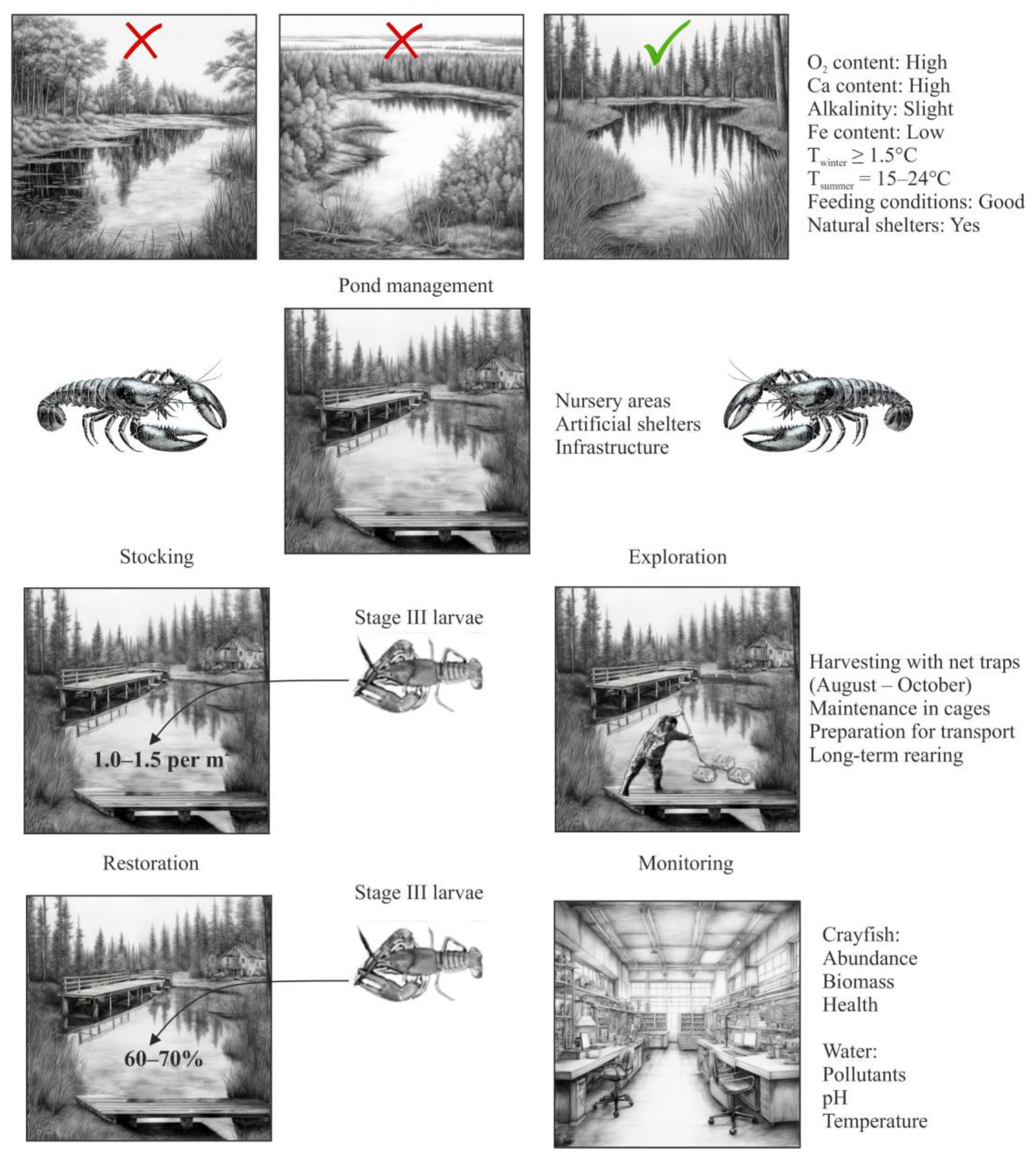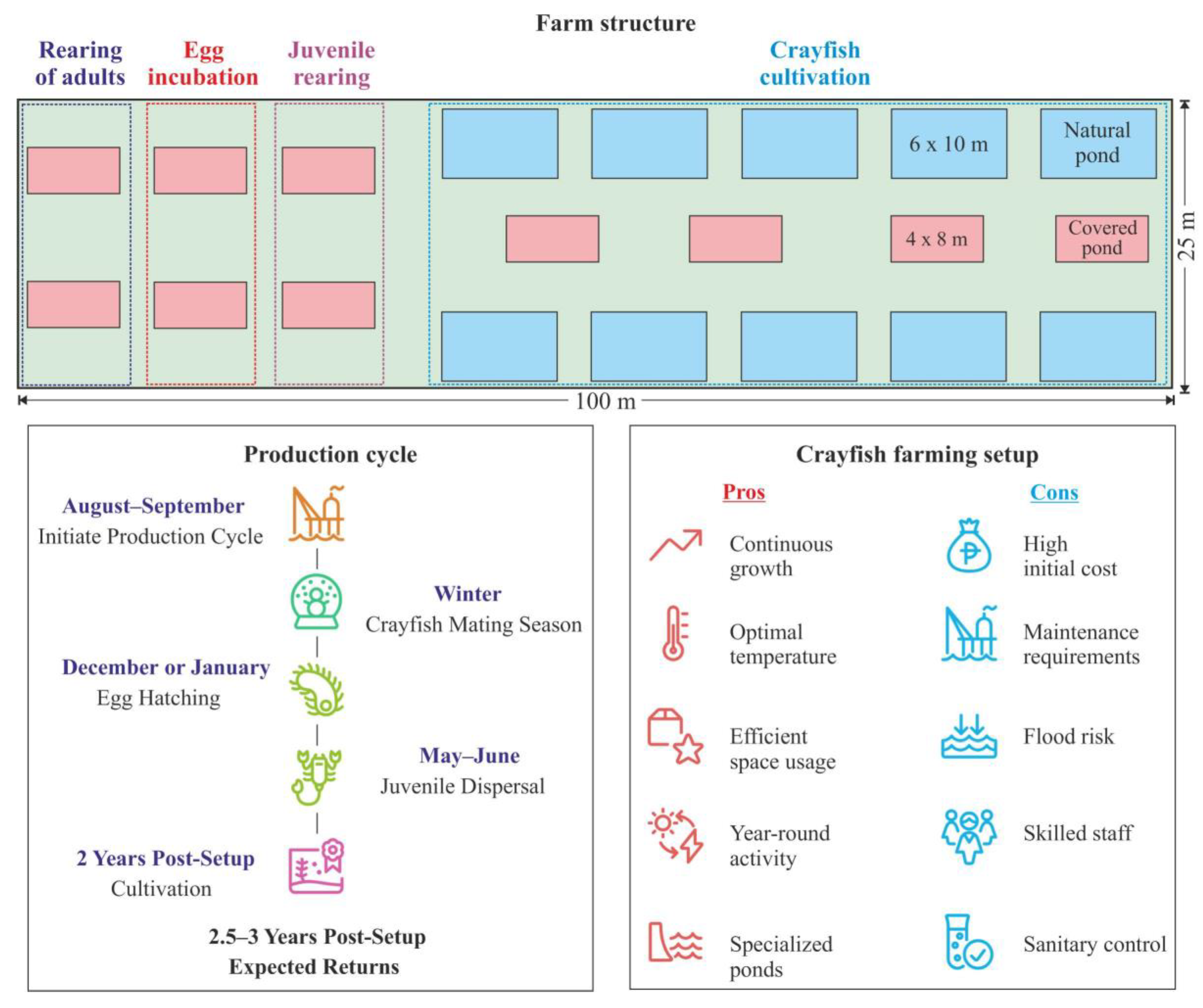Farming of Indigenous Crayfish in Russia: A Mini-Review of Recent Studies
Simple Summary
Abstract
1. Introduction
2. Biological Aspects
2.1. Noble Crayfish
2.2. Narrow-Clawed Crayfish
3. Aquaculture Techniques
3.1. Cultivation Approaches and Requirements
3.2. Seedstock Production
3.3. Production Cycle
3.4. Case Study of Pond Cultivation
3.5. Case Studies of Cultivation in Recirculation Systems
3.6. Management Plan for Crayfish Farm
4. Problems and Solutions
4.1. Diseases
4.2. Cannibalism
4.3. Domestication
4.4. Crayfish Handling
5. Conclusions
Author Contributions
Funding
Institutional Review Board Statement
Informed Consent Statement
Data Availability Statement
Conflicts of Interest
References
- Longshaw, M.; Stebbing, P. (Eds.) Biology and Ecology of Crayfish; CRC Press: London, UK, 2016. [Google Scholar]
- Souty-Grosset, C.; Holdich, D.; Noël, P.; Reynolds, J.; Haffner, P. (Eds.) Atlas of Crayfish in Europe; Coll Patrimoine Naturel, Museum National d’Histoire Naturelle: Paris, France, 2006; Volume 64. [Google Scholar]
- Füreder, L. Crayfish in Europe. In Freshwater Crayfish: A Global Overview; Kawai, T., Faulkes, Z., Scholtz, G., Eds.; CRC Press: Boca Raton, FL, USA, 2016; pp. 594–627. [Google Scholar]
- Meyer-Arendt, K.J.; Henderson, M.L. Crawfish and crawfish festivals in the Pacific Northwest. Yearb. Assoc. Pac. Coast Geog. 2020, 82, 38–67. [Google Scholar] [CrossRef]
- Danilović, M.; Maguire, I.; Füreder, L. Overlooked keystone species in conservation plans of fluvial ecosystems in Southeast Europe: A review of native freshwater crayfish species. Knowl. Manag. Aquat. Ecosyst. 2022, 423, 21. [Google Scholar] [CrossRef]
- Simberloff, D. Flagships, umbrellas and keystones: Is single species management passe in the landscape era? Biol. Conserv. 1998, 83, 247–257. [Google Scholar] [CrossRef]
- Momot, W.T. Redefining the role of crayfish in aquatic ecosystems. Rev. Fish Sci. 1995, 3, 33–63. [Google Scholar] [CrossRef]
- Dorn, N.J.; Wojdak, J.M. The role of omnivorous crayfish in littoral communities. Oecologia 2004, 140, 150–159. [Google Scholar] [CrossRef]
- Veselý, L.; Ercoli, F.; Ruokonen, T.J.; Bláha, M.; Kubec, J.; Buřič, M.; Hämäläinen, H.; Kouba, A. The crayfish distribution, feeding plasticity, seasonal isotopic variation and trophic role across ontogeny and habitat in a canyon-shaped reservoir. Aquat. Ecol. 2020, 54, 1169–1183. [Google Scholar] [CrossRef]
- Alvanou, M.V.; Papadopoulos, D.K.; Lattos, A.; Georgoulis, I.; Feidantsis, K.; Apostolidis, A.P.; Michaelidis, B.; Giantsis, I.A. Biology, distribution, conservation status and stocking perspective of freshwater crayfish in Greece: An Updated Review. Aquac. Res. 2022, 53, 5115–5128. [Google Scholar] [CrossRef]
- Skurlatov, Y.I.; Ernestova, L.S. The impact of human activities on freshwater aquatic systems. Acta Hydrochim. Hydrobiol. 1998, 26, 5–12. [Google Scholar] [CrossRef]
- Dodds, W.K.; Perkin, J.S.; Gerken, J.E. Human impact on freshwater ecosystem services: A global perspective. Environ. Sci. Technol. 2013, 47, 9061–9068. [Google Scholar] [CrossRef]
- Dvoretsky, A.G.; Dvoretsky, V.G. Ecology and distribution of red king crab larvae in the Barents Sea: A review. Water 2022, 14, 2328. [Google Scholar] [CrossRef]
- Dvoretsky, A.G.; Dvoretsky, V.G. Filling knowledge gaps in Arctic marine biodiversity: Environment, plankton, and benthos of Franz Josef Land, Barents Sea. Ocean Coast. Manag. 2024, 249, 106987. [Google Scholar] [CrossRef]
- Dvoretsky, V.G.; Dvoretsky, A.G. Effects of water temperature on zooplankton abundance and biomass in the southwestern Barents Sea: Implications for Arctic monitoring and management. Ocean Coast. Manag. 2025, 261, 107506. [Google Scholar] [CrossRef]
- Dvoretsky, A.G.; Dvoretsky, V.G. Current status of native crayfish populations in Russia: A brief review of their biology and fisheries. Fish. Res. 2025, 281, 107226. [Google Scholar] [CrossRef]
- Borisov, R.R. Decapoda fauna of continental waters of northern Eurasia. In Actual Problems of Studying Crustaceans of Continental Waters, Proceedings of the International School-Conference, Borok, Russia, 5–9 November 2012; Krylov, A.V., Ed.; Kostroma Printing House LLC: Kostroma, Russia, 2012; pp. 7–20. (In Russian) [Google Scholar]
- Alexandrova, E.N. The main results of VNIIR work on scientific and methodological support of crayfish management. In Fishery Use of Reservoirs of Complex Purpose; Servetnik, G.E., Ed.; Rosinformagrotech: Moscow, Russia, 2001; pp. 132–148. (In Russian) [Google Scholar]
- Glushko, E.Y. Crayfish in the reservoirs in Rostov region: State of populations, forecast and management of its stocks in current period. Probl. Fish. 2018, 19, 478–482. (In Russian) [Google Scholar] [CrossRef]
- Glushko, E.Y. Status of populations, stocks and harvesting of crayfish in the Rostov region in 2012–2018. Aquat. Bioresour. Environ. 2019, 2, 68–74. (In Russian) [Google Scholar] [CrossRef]
- Safaraliev, I.A.; Barabanov, V.V.; Maznikova, O.A. Indicator approach in the qualitative assessment of the stock state of the long-clawed crayfish in the Volga River and its watercooms (Astrakhan Region). Tr. VNIRO 2023, 191, 25–36. (In Russian) [Google Scholar] [CrossRef]
- Đuretanović, S.; Rajković, M.; Maguire, I. Freshwater crayfish of the Western Balkans: Is it possible to use them sustainably or do they need prompt conservation actions? In Ecological Sustainability of Fish Resources of Inland Waters of the Western Balkans: Freshwater Fish Stocks, Sustainable Use and Conservation; Springer International Publishing: Cham, Switzerland, 2024; pp. 341–374. [Google Scholar]
- Paolucci, M.; Coccia, E.; Polese, G.; Di Cosmo, A. Current issues on freshwater crayfish aquaculture with a focus on crustacean welfare. In Crustaceans. Endocrinology, Biology and Aquaculture; Zupo, V., Ed.; CRC Press: Boca Raton, FL, USA, 2022; pp. 241–273. [Google Scholar]
- Paaver, T.; Hurt, M. Status and management of noble crayfish Astacus astacus in Estonia. Knowl. Manag. Aquat. Ecosyst. 2009, 18, 394–395. [Google Scholar]
- Franke, R.; Wessels, S.; Hörstgen-Schwark, G. Enhancement of survival and growth in crowded groups: The road towards an intensive production of the noble crayfish Astacus astacus L. in indoor recirculation systems. Aquac. Res. 2013, 44, 451–461. [Google Scholar] [CrossRef]
- Seemann, U.B.; Lorkowski, K.; Slater, M.J.; Buchholz, F.; Buck, B.H. Growth performance of noble crayfish Astacus astacus in recirculating aquaculture systems. Aquac. Int. 2015, 23, 997–1012. [Google Scholar] [CrossRef]
- Dvoretsky, A.G.; Dvoretsky, V.G. Distribution patterns and biological aspects of Strongylocentrotus droebachiensis (Echinoidea: Echinoida) in Russian waters of the Barents Sea: Implications for commercial exploration. Rev. Fish Biol. Fish. 2024, 34, 1215–1229. [Google Scholar] [CrossRef]
- Dvoretsky, A.G.; Dvoretsky, V.G. Aquaculture of green sea urchin in the Barents Sea: A brief review of Russian studies. Rev. Aquac. 2020, 12, 1280–1290. [Google Scholar] [CrossRef]
- Dvoretsky, A.G.; Dvoretsky, V.G. Cucumaria in Russian waters of the Barents Sea: Biological aspects and aquaculture potential. Front. Mar. Sci. 2021, 8, 613453. [Google Scholar] [CrossRef]
- Dvoretsky, A.G.; Dvoretsky, V.G. Biological aspects, fisheries, and aquaculture of yesso scallops in Russian waters of the Sea of Japan. Diversity 2022, 14, 399. [Google Scholar] [CrossRef]
- Alexandrova, E.N. The state of stocks of crayfish of genus Astacus and Pontastacus and the works on their reproduction in Russia. In Scientific Foundations of Agricultural Fish Farming: The State and Prospects of Development; Servetnik, G.E., Ed.; VNIIR: Moscow, Russia, 2010; pp. 131–143. (In Russian) [Google Scholar]
- Alexandrova, E.N. Evaluation of natural populations of crayfish for a selection of sources of wild spawners for cultivation. Vestn. Astrakhan. State Tech. Univ. Fish Ind. 2014, 4, 31–39. (In Russian) [Google Scholar]
- Alexandrova, E.N. Long clawed crayfish as an object of breeding in water bodies of the River Volga Basin. Vestn. Astrakhan. State Tech. Univ. Fish Ind. 2016, 4, 9–19. (In Russian) [Google Scholar]
- Alexandrova, E.N. To the question on prevention and struggle against mycoses of crayfish. In The Latest Genetic Technologies for Aquaculture, Proceedings of the All-Russian Scientific and Practical Conference with International Participation, Moscow, Russia, 29–31 January 2020; Pero: Moscow, Russia, 2020; pp. 11–18. (In Russian) [Google Scholar]
- Alexandrova, E.N.; Belyakova, V.I.; Borisov, R.R.; Komarova, E.A.; Koryakina, N.Y.; Pronina, G.I. Cultivation of crayfish in non-draining reservoirs by pasture type. In Aquaculture and Integrated Technologies: Challenges and Opportunities: Collection of Scientific Papers of the GNU VNIIR and the RGAU–MSHA Named After K.A. Timiryazev on the Results of the International Scientific and Practical Conference Dedicated to the 60th Anniversary of the Moscow Fish Breeding and Reclamation Experimental Station and the 25th Anniversary of the Wildebeest VNIIR; Servetnik, G.E., Ed.; Wildebeest Research Institute of Irrigation Fish Farming: Moscow, Russia, 2005; pp. 86–96. (In Russian) [Google Scholar]
- Alexandrova, E.N.; Belyakova, V.I. The use of small water bodies for cultivation of crayfish in Russian farms. In Integrated Aquaculture Technologies in Farms; Aquagenresource: Moscow, Russia, 2016; pp. 13–18. (In Russian) [Google Scholar]
- Skurdal, J.; Taugbøl, T. Astacus. In Biology of Freshwater Crayfish; Holdich, D.M., Ed.; Blackwell Science: Oxford, UK; pp. 467–510.
- Kivivuori, L.A. Temperature selection behaviour of cold- and warm-acclimated crayfish [Astacus astacus (L.)]. J. Therm. Biol. 1994, 19, 291–297. [Google Scholar] [CrossRef]
- Hudina, S.; Maguire, I.; Klobučar, G.I.V. Spatial dynamics of the noble crayfish (Astacus astacus, L.) in the Paklenica national park. Knowl. Managt. Aquat. Ecosyst. 2008, 388, 1. [Google Scholar] [CrossRef]
- Nyström, P. Ecology. In Biology of Freshwater Crayfish; Holdich, D.M., Ed.; Blackwell Science Ltd.: Oxford, UK, 2002; pp. 192–235. [Google Scholar]
- Pârvulescu, L.; Pacioglu, O.; Hamchevici, C. The assessment of the habitat and water quality requirements of the stone crayfish (Austropotamobius torrentium) and noble crayfish (Astacus astacus) species in the rivers from the Anina Mountains (SW Romania). Knowl. Managt. Aquat. Ecosyst. 2011, 401, 3. [Google Scholar] [CrossRef]
- Kouba, A.; Petrusek, A.; Kozák, P. Continental-wide distribution of crayfish species in Europe: Update and maps. Knowl. Manag. Aquat. Ecosyst. 2014, 413, 5. [Google Scholar] [CrossRef]
- Kaya, N.; Ateşşahin, T.; Fulin, O. Observations on habitat preferences of crayfish species Pontastacus leptodactylus. Ecol. Life Sci. 2024, 19, 43–54. [Google Scholar] [CrossRef]
- Groza, M.I.; Pop-Vancia, V.; Mireşan, V. Diel activity and use of multiple artificially constructed shelters in Astacus leptodactylus (Decapoda: Astacidae). Biologia 2016, 7, 136. [Google Scholar] [CrossRef]
- Dvoretsky, A.G.; Dvoretsky, V.G. Shellfish as biosensors in online monitoring of aquatic ecosystems: A review of Russian studies. Fishes 2023, 8, 102. [Google Scholar] [CrossRef]
- Cherkashina, N.Y. Instruction Manual on Crayfish Cultivation and Dynamics of Their Population; Media Policy LLC: Rostov-on-Don, Russia, 2007. (In Russian) [Google Scholar]
- Lukerin, A.J. Dimensional and age characteristics of the crawfish (Astacus leptodactylus) from basins of Altay Territory. Fish Breed. Fish. 2015, 6, 26–30. (in Russian). [Google Scholar]
- Crandall, K.A.; De Grave, S. An updated classification of the freshwater crayfishes (Decapoda: Astacidea) of the world, with a complete species list. J. Crustacean Biol. 2017, 37, 615–653. [Google Scholar] [CrossRef]
- FAO. FishStat. Global Fisheries and Aquaculture Production 1950–2022. 2024. Available online: https://www.fao.org/fishery/en/fishstat (accessed on 5 January 2025).
- Kolmykov, E.V. Instructions for Breeding River Crayfish; KaspNIRKh: Astrakhan, Russia, 2004. (In Russian) [Google Scholar]
- Harlioğlu, M.M.; Duran, T.C. The effect of darkness on mating and pleopodal egg production time in a freshwater crayfish, Astacus leptodactylus Eschscholtz. Aquac. Int. 2010, 18, 843–849. [Google Scholar] [CrossRef]
- Farhadi, A.; Harlıoglu, M.M. Elevated water temperature impairs gamete production in male narrow-clawed crayfish Pontastacus leptodactylus (Eschscholtz, 1823). Knowl. Manag. Aquat. Ecosyst. 2018, 419, 40. [Google Scholar] [CrossRef]
- Farhadi, A.; Harlıoğlu, M.M.; Gür, S.; Acısu, T.C. Optimization of the incubation time and temperature for spermatozoa extraction in freshwater crayfish Pontastacus leptodactylus (Eschscholtz, 1823). Anim. Reprod. Sci. 2018, 193, 153–157. [Google Scholar] [CrossRef]
- Mazlum, Y.; Uzun, C. Impact of stocking density on the survival, growth and injury of narrow-clawed crayfish (Pontastacus leptodactylus) reared in a flowing brackish water system. Acta Natura Sci. 2022, 3, 163–183. [Google Scholar] [CrossRef]
- Harlıoğlu, M.M. A comparison of the growth and survival of two freshwater crayfish species, Astacus leptodactylus Eschscholtz and Pacifastacus leniusculus (Dana), under different temperature and density regimes. Aquac. Int. 2009, 17, 31–43. [Google Scholar] [CrossRef]
- Ulikowski, D.; Krzywosz, T. Impact of food supply frequency and the number of shelters on the growth and survival of juvenile narrow-clawed crayfish (Astacus leptodactylus Esch.). Fish. Aquat. Life 2006, 14, 225–241. [Google Scholar]
- Ghiasvand, Z.; Matinfar, A.; Valipour, A.; Soltani, M.; Kamali, A. Evaluation of different dietary protein and energy levels on growth performance and body composition of narrow clawed crayfish (Astacus leptodactylus). Iran. J. Fish. Sci. 2012, 11, 63–77. [Google Scholar]
- Özdoğan, H.B.; Koca, H.U. Effects of different diets on growth and survival of first feeding second-stage juvenile Pontastacus leptodactylus (Eschscholtz, 1823) (Decapoda, Astacidea). Crustaceana 2023, 96, 673–682. [Google Scholar] [CrossRef]
- Kiyashko, V.; Vasilyev, A.; Gurkina, O. Crayfish culture in an artificial pond. Agrar Sci J. 2016, 2, 10–12. (In Russian) [Google Scholar]
- Kiyashko, V.; Gurkina, O.; Vasilyev, A.; Dolgopolova, M. Approbation of crayfish culture in industrial environment. Bull. Michurinsk State Agrar. Univ. 2016, 1, 47–50. (In Russian) [Google Scholar]
- Erol, K.G.; Özkök, R.; Cilbiz, N.; Küçükkara, R.; Çinar, Ş.; Tümgelir, L.; Ceylan, M.; Meke, T.; Diler, Ö.; Koca, S.B. Effect of different feed and stocking density on survival and growth performance of Astacus leptodactylus (Esch., 1823) juveniles. J. Limnol. Freshw. Fish. Res. 2017, 3, 159–165. [Google Scholar] [CrossRef]
- Bondarenko, N.V.; Gorbenko, E.V.; Pavlyuk, A.A.; Poluvyanov, P.N.; Stepanova, A.N. Experience on domestication of the crayfish Pontastacus cubanicus in the aquarium-type setup of FSBSI “AZNIIRKH”. Aquat. Biores. Environ. 2018, 1, 97–101. (In Russian) [Google Scholar] [CrossRef]
- Roessler, T.Y.; Wirtz, A.; Slater, M.J.; Henjes, J. Growth performance and RNA/DNA ratio of noble crayfish (Astacus astacus) and narrow-clawed crayfish (Pontastacus leptodactylus) fed fish waste diets. Aquac. Res. 2020, 51, 3205–3215. [Google Scholar] [CrossRef]
- Alvanou, M.V.; Kyriakoudi, A.; Makri, V.; Lattos, A.; Feidantsis, K.; Papadopoulos, D.K.; Georgoulis, I.; Apostolidis, A.P.; Michaelidis, B.; Mourtzinos, I.; et al. Effects of dietary substitution of fishmeal by black soldier fly (Hermetia illucens) meal on growth performance, whole-body chemical composition, and fatty acid profile of Pontastacus leptodactylus juveniles. Front. Physiol. 2023, 14, 1156394. [Google Scholar] [CrossRef]
- Ponomarev, A.K.; Brezhnev, L.L. Assessment of the possibility of joint cultivation of narrow-clawed crayfish and plants by hydroponics. In The State and Ways of Development of Aquaculture in the Russian Federation, Proceedings of the IV National Scientific and Practical Conference, Kaliningrad, Russia, 8–10 October 2019; Vasilyev, A.A., Ed.; Amirit: Saratov, Russia, 2019; pp. 199–202. (In Russian) [Google Scholar]
- Kaya, D.; Genç, E.; Güroy, D.; Dinçer, S.; Yılmaz, B.H.; Yavuzcan, H. Evaluation of biofloc technology for Astacus leptodactylus: Effect of different stocking densities on production performance and physiological responses. Acta Aquat. Turk. 2021, 17, 569–579. [Google Scholar] [CrossRef]
- Startseva, M.L.; Kabenok, D.G. Organization of a crayfish farm using thermal insulation structures. In Materials of Scientific Events Dedicated to the 15th Anniversary of the Southern Scientific Center of the Russian Academy of Sciences: International Scientific Forum “Achievements of Academic Science in the South of Russia”, Proceedings of the International Youth Scientific Conference “Oceanology in the XXI Century: Modern Facts, Models, Methods and Means” in Memory of Corresponding Member of the Russian Academy of Sciences D.G. Matishov; All-Russian Scientific Conference “Aquaculture: World Experience and Russian Developments”, Rostov-on-Don, Russia, 13–16 December 2017; Matishov, G.G., Ed.; SSC RAS Press: Rostov-on-Don, Russia, 2017; pp. 518–520. (In Russian) [Google Scholar]
- Vasileva, P.; Zaikov, A.; Hubenova, T. Investigation on reproductive potential in male narrow-clawed crayfish Astacus leptodactylus Esch. Bulg. J. Agric. Sci. 2006, 12, 218–225. [Google Scholar]
- Longshaw, M. Diseases of crayfish: A review. J. Invertebr. Pathol. 2011, 106, 54–70. [Google Scholar] [CrossRef] [PubMed]
- Unestam, T. Studies on the crayfish plague fungus Aphanomyces astaci. II. Factors affecting zoospores and zoospore production. Physiol. Plant. 1966, 19, 1110–1119. [Google Scholar] [CrossRef]
- Cerenius, L.; Söderhäll, K.; Persson, M.; Ajaxon, R. The crayfish plague fungus, Aphanomyces astaci–diagnosis, isolation and pathobiology. Freshw. Crayfish 1988, 7, 131–144. [Google Scholar]
- Vrålstad, T.; Johnsen, S.I.; Fristad, R.F.; Edsman, L.; Strand, D. Potent infection reservoir of crayfish plague now permanently established in Norway. Dis. Aquat. Org. 2011, 97, 75–83. [Google Scholar] [CrossRef]
- Alexandrova, E.N.; Tarasov, K.L. Biology of causative agents of crayfish mycoses in connection with environmental protection in crayfish producing reservoirs. IOP Conf. Ser. Earth Environ. Sci. 2020, 421, 082027. [Google Scholar] [CrossRef]
- Diéguez-Uribeondo, J.; Cerenius, L.; Söderhäll, K. Saprolegnia parasitica and its virulence on three different species of crayfish. Aquaculture 1994, 120, 219–228. [Google Scholar] [CrossRef]
- Borisov, R.R.; Tertitskaya, A.G. Cannibalistic behavior of the crayfish (Pontastacus leptodactylus) juveniles reared on various substrates. In Aquaculture and Integrated Technologies: Problems and Opportunities: Materials of the International Scientific and Practical Conference Dedicated to the 60th Anniversary of the Moscow Fish Breeding and Reclamation Experimental Station and the 25th Anniversary of its Reorganization into the GNU VNIIR. Collection of Scientific Papers, Vol. 1; Servetnik, G.E., Ed.; Wildebeest Research Institute of Irrigation Fish Farming: Moscow, Russia, 2005; pp. 382–386. (In Russian) [Google Scholar]
- Mazlum, Y.; Gurlek, O.G.; Sirin, S. Effect of different substrates on survival and growth of juveniles of the freshwater narrow-clawed crayfish Astacus leptodactylus Eschscholtz, 1823 (Decapoda, Astacidae). Crustaceana 2017, 90, 1289–1302. [Google Scholar] [CrossRef]
- Farhadi, A.; Gardner, C.; Kochanian, P. Reducing cannibalism of narrow clawed crayfish Astacus leptodactylus Eschscholtz 1823 through management of photoperiod and stocking density. Asian Fish. Sci. 2014, 27, 286–296. [Google Scholar] [CrossRef]
- Gydemo, R.; Westin, L. Growth and survival of juvenile Astacus astacus L. at optimized water temperature. In Aquaculture: A Biotechnology in Progress; De Pauw, N., Jaspers, E., Ackefors, H., Wilkins, N., Eds.; European Aquaculture Society: Oostende, Belgium, 1989; pp. 383–391. [Google Scholar]
- Ackefors, H.; Castell, J.D.; Boston, L.D.; Räty, P.; Svensson, M. Standard experimental diets for crustacean nutrition research. II. growth and survival of juvenile crayfish Astacus astacus (Linné) fed diets containing various amounts of protein, carbohydrate and lipid. Aquaculture 1992, 104, 341–356. [Google Scholar] [CrossRef]
- Taugbøl, T.; Skurdal, J. Growth, mortality and moulting rate of noble crayfish Astacus astacus L. juveniles in aquaculture experiments. Aquac. Fish. Manag. 1992, 23, 411–420. [Google Scholar] [CrossRef]
- Webber, H.H.; Riordan, P.F. Criteria for candidate species for aquaculture. Aquaculture 1976, 7, 107–123. [Google Scholar] [CrossRef]
- Jussila, J.; Fotedar, R.; Edsman, L. Post-harvest handling of freshwater crayfish: Techniques, challenges and opportunities. In Postharvest Handling; Kahramanoglu, I., Ed.; IntechOpen: London, UK, 2017; pp. 179–195. [Google Scholar]
- Neill, D.M. Ensuring crustacean product quality in the post-harvest phase. J. Invert. Pathol. 2012, 110, 267–275. [Google Scholar] [CrossRef] [PubMed]
- Jussila, J. On the economics of crayfish trapping in Central Finland in 1989–90. Freshw. Crayfish 1995, 8, 215–227. [Google Scholar]
- Piersanti, S.; Pallottini, M.; Salerno, G.; Goretti, E.; Elia, A.C.; Dörr, A.J.M.; Rebora, M. Resistance to dehydration and positive hygrotaxis in the invasive red swamp crayfish Procambarus clarkii. Knowl. Manag. Aquat. Ecosyst. 2018, 419, 36. [Google Scholar] [CrossRef]
- Jussila, J.; Tiitinen, V.; Fotedar, R.; Kokko, H. A simple and efficient cooling method for post-harvest transport of the commercial crayfish catch. Freshw. Crayfish 2013, 19, 15–19. [Google Scholar] [CrossRef]
- Diggles, B.K. Review of some scientific issues related to crustacean welfare. ICES J. Mar. Sci. 2019, 76, 66–81. [Google Scholar] [CrossRef]





| Parameter | Noble Crayfish | Narrow-Clawed Crayfish |
|---|---|---|
| Location and hydrology | Clear glacial lakes and the upper sections of their flowing rivers (north-western part of Russia, Leningrad Oblast) | Bays of plain rivers, lakes, and quarries with clean water (Upper and Middle Volga basin) |
| Catchment area conditions | Predominance of non-swamp forests and meadows; absence of pollution sources and low recreation activity | Predominance of non-swamp forests and meadows; absence of pollution sources and low recreation activity |
| Pond area, ha | 10–100 | 100–1000 |
| Pond depth, m | 4 m | 4 m |
| Yearly water exchange, km3 For deep water bodies For intermediate water bodies For shallow water bodies | <0.25 0.25–1 >4–16 | <0.25 1–4 >4–16 |
| Averaged water temperatures in summer, °C | 10–15 | 15–20 |
| Degree-days with t > 10 °C | 1000–2000 | >2000 |
| Area of potential crayfish colonization, % | ≥30 | ≥30 |
| Area occupied by aquatic plants, % | ≥30 | <25 |
| Zooplankton biomass, g m−3 | <2.55 | n.d. |
| Zoobenthos biomass, g m−2 | >10 | n.d. |
| Parameter | Noble Crayfish | Narrow-Clawed Crayfish |
|---|---|---|
| Maximum water temperature, °C | <24 | <26 |
| Water transparency established with a Secchi disc, m | 4–8 | >1–2 |
| Dissolved oxygen, mg L−1 | >6–7 | >5–6 |
| pH | 7.5–8.3 | 6.8–8.8 |
| Ca2+ + HCO3−, % | 90 | 76 |
| Ca2+, mg L−1 | 42.2–48.8 | 32.0–64.2 |
| HCO3−, mg L−1 | 171.4–210.4 | 113.0–190.0 |
| Fe, mg L−1 | <0.5 | <0.5 |
| NH4−, mg L−1 | <0.06 | <0.1 |
| NO3−, mg L−1 | <0.03 | <0.03 |
| Permanganate oxidizability, mgO L−1 | <10 | <15 |
| Bacterial abundance, million cells L−1 | <1.5 | <2 |
| Saprophytic bacteria, thousand cells L−1 | <0.5 | – |
| Ratio of cocci to rod-shaped bacteria | – | 1:0.9 |
| Escherichia coli, thousand cells L−1 | <10 | – |
| Zooplankton biomass, g m−3 | 4–7 | 1.5–5 |
| Zoobenthos biomass, g m−2 | 9–36 | 3–4 |
| Aquatic flora | Charophyceae | Potamogetonaceae, Ceratophyllaceae, Nymphaeaceae |
| Aquatic plant area, % | >20 | 15–20 |
| Stage/Age | Mean Crayfish Weight, mg | Natural Feeds | Formulated Feeds | ||
|---|---|---|---|---|---|
| mg w.w. | % from Crayfish w.w. | mg w.w. | % from Crayfish w.w. | ||
| Larvae | 34.65 | 13.39 | 38.50 | 4.5 | 13.0 |
| Juvenile 0+ | 121.30 | 27.22 | 22.44 | 9.1 | 7.5 |
| Juvenile 24d | 238.20 | 30.09 | 16.41 | 13.0 | 5.47 |
| Juvenile 40d | 591 | 78.90 | 13.35 | 26.3 | 3.4 |
| Juvenile 60d | 1506 | 122.14 | 8.11 | 40.7 | 2.7 |
| Juvenile 90d | 2905 | 184.42 | 6.40 | 61.47 | 2.1 |
| Juvenile 120d | 5080 | 275.59 | 5.43 | 91.86 | 1.81 |
| Juvenile 1+ | 7710 | 457.97 | 5.94 | 152.65 | 1.98 |
| Juvenile 1+ | 17820 | 559.55 | 3.14 | 186.51 | 1.04 |
| Juvenile 1+ | 31992 | 642.29 | 2.01 | 214.1 | 0.67 |
| Attribute | Noble Crayfish | Narrow-Clawed Crayfish |
|---|---|---|
| High nutrition quality and prices for products | 2 | 1 |
| High adaptability to artificial conditions | 2 | 2 |
| High ability to reproduce under artificial conditions | 2 | 2 |
| Rapid growth rate | 0 | 1 |
| Low aggressiveness under joint cultivation | 1 | 0 |
| Resistance to disease | 0 | 1 |
| High survival and yield rate | 1 | 2 |
| High tolerance to environmental disturbances | 0 | 1 |
| Diet plasticity and low feed costs | 2 | 2 |
| Mean score | 1.11 | 1.33 |
Disclaimer/Publisher’s Note: The statements, opinions and data contained in all publications are solely those of the individual author(s) and contributor(s) and not of MDPI and/or the editor(s). MDPI and/or the editor(s) disclaim responsibility for any injury to people or property resulting from any ideas, methods, instructions or products referred to in the content. |
© 2025 by the authors. Licensee MDPI, Basel, Switzerland. This article is an open access article distributed under the terms and conditions of the Creative Commons Attribution (CC BY) license (https://creativecommons.org/licenses/by/4.0/).
Share and Cite
Dvoretsky, A.G.; Dvoretsky, V.G. Farming of Indigenous Crayfish in Russia: A Mini-Review of Recent Studies. Animals 2025, 15, 223. https://doi.org/10.3390/ani15020223
Dvoretsky AG, Dvoretsky VG. Farming of Indigenous Crayfish in Russia: A Mini-Review of Recent Studies. Animals. 2025; 15(2):223. https://doi.org/10.3390/ani15020223
Chicago/Turabian StyleDvoretsky, Alexander G., and Vladimir G. Dvoretsky. 2025. "Farming of Indigenous Crayfish in Russia: A Mini-Review of Recent Studies" Animals 15, no. 2: 223. https://doi.org/10.3390/ani15020223
APA StyleDvoretsky, A. G., & Dvoretsky, V. G. (2025). Farming of Indigenous Crayfish in Russia: A Mini-Review of Recent Studies. Animals, 15(2), 223. https://doi.org/10.3390/ani15020223








